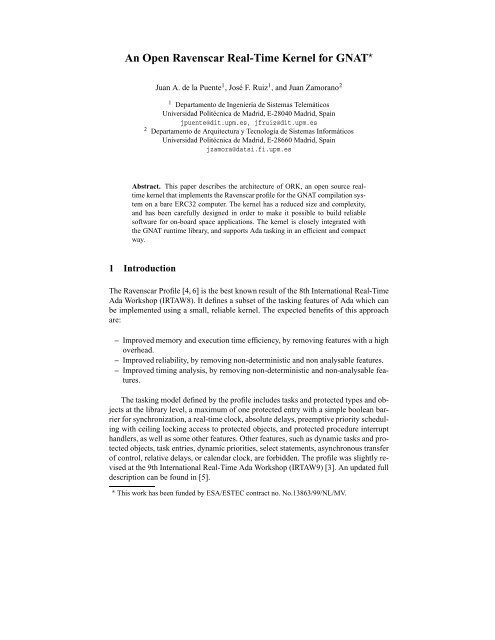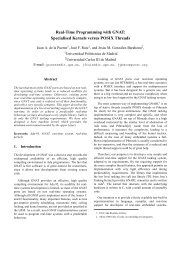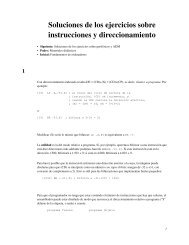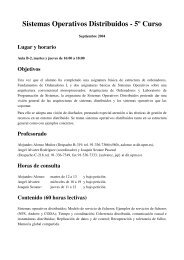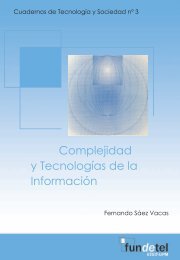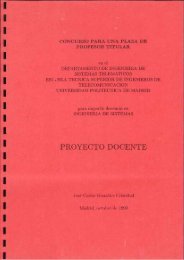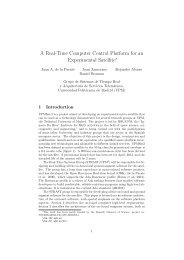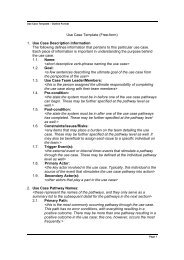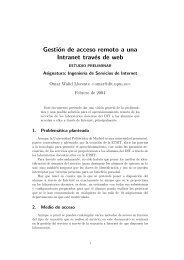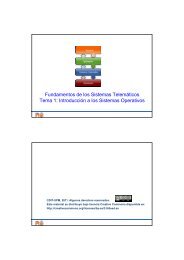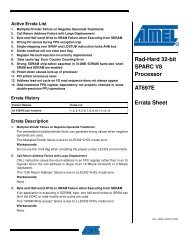An Open Ravenscar Real-Time Kernel for GNAT - DIT - Universidad ...
An Open Ravenscar Real-Time Kernel for GNAT - DIT - Universidad ...
An Open Ravenscar Real-Time Kernel for GNAT - DIT - Universidad ...
Create successful ePaper yourself
Turn your PDF publications into a flip-book with our unique Google optimized e-Paper software.
Only the first four of these packages are visible to GNULL. The other three, <strong>Kernel</strong>.Parameters,<strong>Kernel</strong>.CPU_Primitives, and <strong>Kernel</strong>.Peripherals, are used only by otherkernel packages, and encapsulate implementation dependent elements in order to makeit easier to port the kernel to other hardware environments.Some of the packages (e.g. <strong>Kernel</strong>.Threads) have additional children that extendtheir interfaces so that some of their internal functionality is made visible to other kernelpackages.<strong>Kernel</strong>.Memory<strong>Kernel</strong>{Storage Allocation}{Thread Management}{Synchronization}{Scheduling}<strong>Kernel</strong>.Threads<strong>Kernel</strong>.CPU_Primitives{Interrupt Handling}{<strong>Time</strong> Keeping and Delays}<strong>Kernel</strong>.InterruptsE<strong>Kernel</strong>.Parameters<strong>Kernel</strong>.<strong>Time</strong><strong>Kernel</strong>.PeripheralsFig. 4. Architecture of the <strong>Open</strong> <strong>Ravenscar</strong> <strong>Real</strong>-<strong>Time</strong> <strong>Kernel</strong>3.2 Thread managementAda tasks are implemented at the lower level by kernel threads. Threads are created atprogram startup, so that there is no need to dynamically allocate or deallocate resourcessuch as TCBs or stack space.Threads are scheduled according to the FIFO within priorities policy (ALRM [2],D2). There is a ready queue which is ordered by priority and arrival order. The synchronizationprimitives directly insert or remove threads from the ready queue.Two kinds of synchronization elements are provided by the kernel: mutexes andcondition variables. These elements are used by GNARL to implement protected objects.Despite the name similarity with POSIX, ORK synchronization primitives aredefined in such a way that the related GNULLI elements can be directly implemented,thus enabling a more efficient implementation of protected objects. We have taken ad-
vantage of the <strong>Ravenscar</strong> profile restrictions to implement only one kind of mutualexclusion locks.Condition variables are also simplified with respect POSIX, in that there are notimed waits and there are no suspended task queues, as the maximum number of tasksthat can be waiting on a condition is one. The fact that the <strong>Ravenscar</strong> profile doesnot allow select statements, timed wait operations, or ATCs, has also resulted in greatsimplification.Locks implement the Immediate Priority Ceiling Protocol (IPCP), which is thesame as the Ceiling Locking policy defined by the ALRM [2] (D3).3.3 <strong>Time</strong> managementThe package <strong>Kernel</strong>.<strong>Time</strong> provides timing support in a very simplified way. A time typeis defined that represents both absolute time and time intervals as an integer number ofnanoseconds. There is a monotonic clock that gives an absolute time value, measuredfrom system startup.According to the <strong>Ravenscar</strong> profile specification, only an absolute delay (delay until)operation is provided. Delayed threads are kept in a delay queue which is ordered bywakeup time. Since a delay cannot be canceled, as there are no abort statements orATCs, there is no need to keep delayed threads waiting on a condition variable, ascurrent GNARL implementations do.3.4 Storage managementAlthough the <strong>Ravenscar</strong> profile does not <strong>for</strong>bid all kinds of dynamic storage management,as the profile does not deal with non tasking features of Ada, it seems reasonableto expect <strong>Ravenscar</strong> compliant programs not to use dynamic storage pools. Consequently,only a limited <strong>for</strong>m of memory management is provided, in order to allocateTCB and stack space <strong>for</strong> new threads. Since threads can only be created at systemstartup, and cannot terminate, this restricted <strong>for</strong>m of storage allocation can be made ina safe way, using a simple linear algorithm.The task stacks are protected in order to avoid stack overflow or underflow. Thehardware segment protection mechanism is used <strong>for</strong> this purpose.3.5 Interrupt handling<strong>An</strong> interrupt represents a class of events that are detected by the hardware or the kernelitself. When an interrupt occurs an Interrupt Service Routine (ISR) is invoked to makethe interrupt available to the kernel. In Ada 95, a high-level handler can be attached tothe interrupt so that is is automatically started by the runtime system when the interruptoccurs. The handler may be a parameterless protected procedure or a task entry,although the latter is only included <strong>for</strong> compatibility with Ada 83.Current GNARL implementations use interrupt service tasks that are activated whenan interrupt occurs, and then call the associated interrupt handler procedure. In this way,priorities and mutual exclusion are handled in the standard way <strong>for</strong> tasks and protected
objects. Interrupt handlers are executed in the context of the interrupt service tasks,which gives a clean execution model compared to other approaches in which the handleris executed in the context of the interrupted task.ORK follows a different approach. Under the <strong>Ravenscar</strong> profile restrictions onlyprotected procedure handlers can be defined. Moreover, the only possible locking policyis Ceiling Locking. This means that an interrupt handler can never be blocked waiting<strong>for</strong> a protected object to become free. Since all interrupts are disabled while updatingthe kernel internal data (see 3.6 below), there is no need <strong>for</strong> complex mutual exclusionmechanisms. Actually, interrupt handlers are executed as if they were directly invokedby the interrupted task, with the difference that the interrupt stack is used instead of thetask stack.The <strong>Kernel</strong>.Interrupts package provides symbolic interrupt names and operations<strong>for</strong> attaching and detaching interrupt handlers. The handlers are directly attached to theinterrupts, without the burden of using POSIX signals as the current GNARL does.3.6 Other design issuesThe kernel interface is a purely procedural one, as there is no need <strong>for</strong> separate userand supervisor execution modes. All the program runs in supervisor mode, as it is commonin embedded systems. Mutual exclusion in the kernel is achieved by means of amonolithic monitor [15] protected by disabling interrupts, so that interrupt delivery ispostponed when a kernel function is executed [17, 16].Mutex lock operations are implemented by simply raising the locking thread activepriority to the ceiling priority of the mutex. This is consistent with the implementationproposed by the Ada Rationale [13] <strong>for</strong> protected objects.4 Related workThis project builds on some of the results of previous ESA projects which resulted inthe development of the current ERC32 GNU Cross Compilation system [10], whichincludes an Ada cross-compilation system <strong>for</strong> the ERC32 computer based on <strong>GNAT</strong>and RTEMS, an open real-time operating system.The JTK kernel, which was developed at the Technical University of Madrid, [7,17], has provided some background <strong>for</strong> the development of ORK. We have also beeninspired by the Top Layer kernel [14].Other previous work of interest to the project includes Aonix’ Raven [8], and thekernels developed at the Florida State University [19, 18] and the University of York[20].5 Status and availabilityThe first version of the kernel has been fully implemented, and is available at the ORKproject server, www.openravenscar.org. The distribution package includes sourcepatches <strong>for</strong> the <strong>GNAT</strong> 3.13 runtime library, and GDB scripts, in addition to the kernelitself.
ORK is free software, and is distributed with the same license as <strong>GNAT</strong> (a slightlymodified GNU Public License). This means that everybody is free to read the ORKsource code, modify it, and redistribute it, provided they give others the same freedom.ORK is currently maintained on a voluntary basis <strong>for</strong> the general public.6 Conclusions and future workORK has been designed to provide an open source implementation of the <strong>Ravenscar</strong>profile. Although the ORK project is primarily targeted to the on-board space softwaredomain, we expect that it will be useful to the hard real-time systems community atlarge.We plan to port ORK to other hardware plat<strong>for</strong>ms, starting with the ix86 PC compatiblearchitecture, in the near future. This will enable it to be used in other applicationdomains, and also in real-time systems education.AcknowledgmentsORK was developed by a team of the Department of Telematics Engineering TechnicalUniversity of Madrid (<strong>DIT</strong>/UPM), lead by Juan <strong>An</strong>tonio de la Puente. The other membersof the team were Juan Zamorano, José F. Ruiz, Ramón Fernández, and RodrigoGarcía. Alejandro Alonso and Ángel Álvarez acted as document and code reviewers,and contributed to the technical discussions with many fruitful comments and suggestions.The same team developed the adapted packages that enable <strong>GNAT</strong> to work withORK.GDB was adapted to ORK by a Jesús González-Barahona, Vicente Matellán, <strong>An</strong>drésArias, and Juan Manuel Dodero. José Centeno and Pedro de las Heras acted asreviewers <strong>for</strong> this part of the work. All of them work at the King Juan Carlos Universityof Madrid.The ORK software was validated by Jesús Borruel and Juan Carlos Morcuende,from Construcciones Aeronáuticas (CASA), Space Division. We also relied very muchon <strong>An</strong>dy Wellings and Alan Burns, of York University, <strong>for</strong> reviewing and discussionsabout the <strong>Ravenscar</strong> profile and its implementation.ORK was developed under contract with ESA, the European Space Agency. JorgeAmador, Tullio Vardanega and Jean-Loup Terraillon provided many positive criticismand contributed the user’s view during the development. The project was carried outfrom September, 1999 to early June, 2000.References1. Ada Core Technologies. <strong>GNAT</strong> Reference Manual. Version 3.13a, March 2000.2. Ada 95 Reference Manual: Language and Standard Libraries. International StandardANSI/ISO/IEC-8652:1995, 1995. Available from Springer-Verlag, LNCS no. 1246.3. Lars Asplund, Bob Johnson, and Kristina Lundqvist. Session summary: The <strong>Ravenscar</strong>profile and implementation issues. Ada Letters, XIX(25):12–14, 1999. Proceedings of the9th International <strong>Real</strong>-<strong>Time</strong> Ada Workshop.
4. Ted Baker and Tullio Vardanega. Session summary: Tasking profiles. Ada Letters,XVII(5):5–7, 1997. Proceedings of the 8th International Ada <strong>Real</strong>-<strong>Time</strong> Workshop.5. Alan Burns. The <strong>Ravenscar</strong> profile. Technical report, University of York, 1999. Available athttp://www.cs.york.ac.uk/rts/papers/p.ps.6. Alan Burns, Brian Dobbing, and George Romanski. The <strong>Ravenscar</strong> profile <strong>for</strong> high integrityreal-time programs. In Lars Asplund, editor, Reliable Software Technologies — Ada-Europe’98, number 1411 in LNCS. Springer-Verlag, 1998.7. Juan A. de la Puente, José F. Ruiz, and Jesús M. González-Barahona. <strong>Real</strong>-time programmingwith <strong>GNAT</strong>: Specialised kernels versus POSIX threads. Ada Letters, XIX(2):73–77,1999. Proceedings of the 9th International <strong>Real</strong>-<strong>Time</strong> Ada Workshop.8. Brian Dobbing and George Romanski. The <strong>Ravenscar</strong> profile: Experience report. Ada Letters,XIX(2):28–32, 1999. Proceedings of the 9th International <strong>Real</strong>-<strong>Time</strong> Ada Workshop.9. ESA. 32 Bit Microprocessor and Computer System Development, 1992. Report9848/92/NL/FM.10. Jiri Gaisler. The ERC32 GNU Cross-Compiler System. ESA/ESTEC, 1999. Version 2.0.6.11. E.W. Giering and T.P. Baker. The GNU Ada Runtime Library (GNARL): Design and implementation.In Proceedings of the Washington Ada Symposium, 1994.12. IEEE. Portable Operating System Interface (POSIX) — Part 1: System Application ProgramInterface (API) [C Language] (Incorporating IEEE Stds 1003.1-1990, 1003.1b-1993,1003.1c-1995, and 1003.1i-1995), 1990. ISO/IEC 9945-1:1996.13. Intermetrics. Ada 95 Rationale: Language and Standard Libraries., 1995. Available fromSpringer-Verlag, LNCS no. 1247.14. M. Kamrad and B. Spinney. <strong>An</strong> Ada runtime system implementation of the <strong>Ravenscar</strong> profile<strong>for</strong> a high speed application layer data switch. In Michael González-Harbour and Juan A.de la Puente, editors, Reliable Software Technologies — Ada-Europe’99, number 1622 inLNCS, pages 26–38. Springer-Verlag, 1999.15. A.K. Mok. The design of real-time programming systems based on process models. In IEEE<strong>Real</strong>-<strong>Time</strong> Systems Symposium. IEEE Computer Society Press, 1984.16. Frank Mueller. A library implementation of POSIX threads under UNIX. In Proceedings ofthe USENIX Conference, pages 29–41, January 1993.17. José F. Ruiz and Jesús M. González-Barahona. Implementing a new low-level tasking support<strong>for</strong> the <strong>GNAT</strong> runtime system. In Michael González-Harbour and Juan A. de la Puente,editors, Reliable Software Technologies — Ada-Europe’99, number 1622 in LNCS, pages298–307. Springer-Verlag, 1999.18. H. Shen and T.P. Baker. A Linux kernel module implementation of restricted Ada tasking.Ada Letters, XIX(2):96–103, 1999. Proceedings of the 9th International <strong>Real</strong>-<strong>Time</strong> AdaWorkshop.19. H. Shen, A. Charlet, and T.P. Baker. A ’bare-machine’ implementation of Ada multi-taskingbeneath the Linux kernel. In Michael González-Harbour and Juan A. de la Puente, editors,Reliable Software Technologies — Ada-Europe’99, number 1622 in LNCS, pages 287–297.Springer-Verlag, 1999.20. W.M. Walker, P.T. Wooley, and A. Burns. <strong>An</strong> experimental testbed <strong>for</strong> embedded real timeAda 95. Ada Letters, XIX(2):84–89, 1999. Proceedings of the 9th International <strong>Real</strong>-<strong>Time</strong>Ada Workshop.


